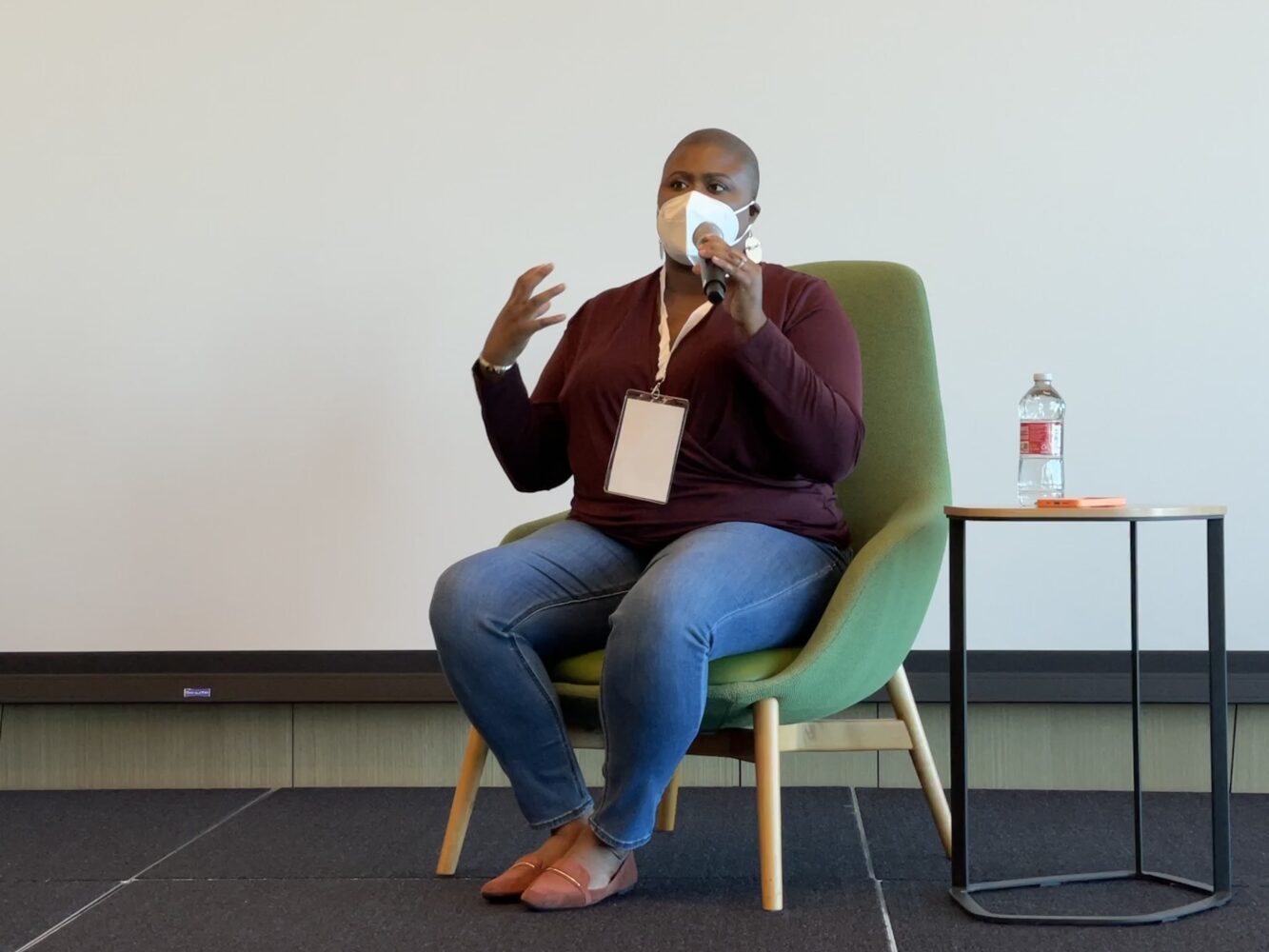
Patient advocates urge science journalists to present more diverse perspectives on Long COVID
Chimére L. Sweeney, a patient advocate, implores an audience of science journalists to tell the untold stories of those suffering from Long COVID. (Photo by Deviyani Rao)
“It’s time to turn the page on Long COVID,” said patient advocate and storyteller Chimére L. Sweeney, speaking to science writers in Aurora, Colo. Oct. 8 during the Council for the Advancement of Science Writing’s New Horizons in Science briefings at ScienceWriters2023. Frustrated with the way newsrooms cover Long COVID, Sweeney urged her audience to tell new stories, specifically those of underrepresented populations.
Along with almost 20 million others in the United States, Sweeney was infected by the SARS-CoV-2 virus in 2020. But unlike the majority who fully recovered, Sweeney continued to suffer from devastating symptoms. “I was literally in my room for nine months, dying,” said Sweeney.
For Sweeney, obtaining a Long COVID diagnosis was difficult. Her doctor either downplayed her symptoms or suggested they weren’t real. “I was simply asking him what does he think is happening to me, and why is it happening,” said Sweeney. “He said I needed a psychiatric evaluation.”
Having to fight for a diagnosis is not uncommon. According to a 2022 study published in the social science journal SSM—Qualitative Research in Health, patients suffering from Long COVID have often reported being “gaslit” when talking to their doctors about their symptoms. The same study found a positive correlation between the dismissal of symptoms and patients’ gender, with healthcare providers often initially attributing female patients’ Long COVID symptoms to “women’s troubles.”
A Black middle-school teacher, Sweeney said her experience is not uncommon. She recalled the lack of representation in initial news stories that covered those suffering from COVID-19. “It wasn’t until three or four months after COVID became real to all of us that I saw my first story about a Black woman,” Sweeney said.
From patients to patient advocates
Despite the setbacks, Sweeney eventually obtained a Long COVID diagnosis through self-advocacy and became an advocate for others suffering from the disease. She has written a chapter in The Long COVID Survival Guide, conducted multiple interviews, and started support groups to bring awareness to those with the condition.
Two other Long COVID patient advocates joined Sweeney on the panel over Zoom: Fiona Lowenstein, an independent journalist, and Julia Moore Vogel, who leads The Participant Center, part of the “All of Us” program of the U.S. Department of Health Services, at Scripps Research Institute in San Diego, Calif.
Before the global pandemic, Lowenstein was an advocacy-based journalist, focusing on feminism and the LGBTQIA+ community, where they started the Body Politic collective. After their Long COVID diagnosis in 2020, Lowenstein served as editor on The Long COVID Survival Guide and started the Body Politic Covid-19 Support Group.
Vogel applied her administrative and scientific skills to help others with Long COVID. Diagnosed with COVID in July of 2020, Vogel now leads both the Long COVID Wearable Study, which aims to use wearable technology to help manage Long COVID symptoms, and the ImmunoCARE Study, which focuses on reducing the severity of COVID symptoms. Even as Vogel helps push the research on Long COVID forward, managing her own symptoms is still a daily struggle. “The biggest thing for me is just how absolutely relentless it is, and how much you have to shrink your life,” Vogel said.
Where the science stands
Sweeney, Lowenstein, and Vogel all suffer from extreme fatigue caused by Long COVID, but the disease can cause a wide range of symptoms. Along with fatigue, the Centers for Disease Control and Prevention states that people suffering from Long COVID can experience neurological, respiratory, and even digestive symptoms. These symptoms, which can look like “brain fog” or difficulty breathing, may come and go, and can become worse when patients perform tasks that are physically or mentally demanding.
Such symptoms are not unique to Long COVID. Other, more-studied diseases, such as myalgic encephalomyelitis/chronic fatigue syndrome and dysautonomia, share many similarities. And although Long COVID researchers may feel the need to “reinvent the wheel,” Lowenstein suggested that what’s known about these other diseases could prove useful for understanding, and treating, Long COVID.
Long COVID can no longer be considered a new disease, especially to those like Sweeney, Lowenstein, and Vogel, who have each been living with the condition for over three years. But what should be new, the patient advocates argued, are the stories journalists cover.
“Think about the ‘-ology’ of what story you choose to tell,” urged Sweeney. “The biology. The ecology. But most importantly, the pathology of [BIPOC] people. Because they are not monolithic.”